The test knit of the English pattern to Oili is completed and I am happy to release the pattern on Ravelry. Oili was first published in Norwegian in Familien Strikk last August. Above you see it worn by the stunning model Anne Dorthe/Team Models, with hair & make up by Sissel Fylling, jewelry by Kaja Gjedebo Design all brilliantly captured by Eivind Røhne at Henie Onstad Kunstsenter last May. Here is my introduction to the pattern: Playful cables are the focus of this classic straight top, knitted in the round with each side marked by garter stitches. Narrow bands of garter stitch band frame the armholes, neckline and bottom edge. The top has a matching cowl, with cables all around. The set is knitted in a soft cotton tape yarn by Permin, called Bonnie, to make you feel like a divine woman – the meaning of the name Oili.
Sizes: Top: XS (S, M, L, XL, 2XL). Cowl: One size
Finished measurements: Top: Bust: 84.5 (92.5, 98, 106, 116, 126.5) cm/33.25 (36.25, 38.5, 41.75, 45.75, 49.75)” Length: 55 (57, 58.5, 59.5, 62, 64) cm/21.75 (22.5, 23, 23.5, 24.5, 25.25)”. Cowl: Circumference 40 cm/15.75″. Length: 128 cm/50.50″
Yarn: Permin, Bonnie (100% cotton, 50 g, 220 m/240 yds). Sample is knitted in Pale Blue 881017. http://www.permin.dk/uk/knitting-yarn/permin-knitting-yarn/bonnie.html Top: 4 (4, 5, 5, 5, 6) skeins; 739 (814, 888, 990, 1091, 1192) m/808 (890, 971, 1083, 1196, 1304) yds. Cowl: 5 skeins; 977 m/1068 yds
Yarn alternatives: See pattern page or choose another Sport/5 ply yarn.
Needles: 4 mm/US 6 circular needle (80 cm/32″) for top. 4 mm/US 6 circular needle (40 cm/16″) for cowl. 3.5 mm/US 4 circular needle (40 cm/16″) for bands. Adjust needle size as needed to match gauge.
Notions: 3 stitch markers, cable needle, waste yarn, 4 mm/F-5 crochet hook (for provisional cast-on) and yarn needle.
Gauge: 24 sts and 32 rows in st st using 4 mm/US 6 measures 10 cm/4″ square. 1 cable using 4 mm/US 6 measures 6 cm/2.25″ wide and 16 cm/6.25″ long.
Notes: The top is worked in the round to the armholes, then separated. The cowl is worked in the round as a long tube, and then the ends are joined together.

